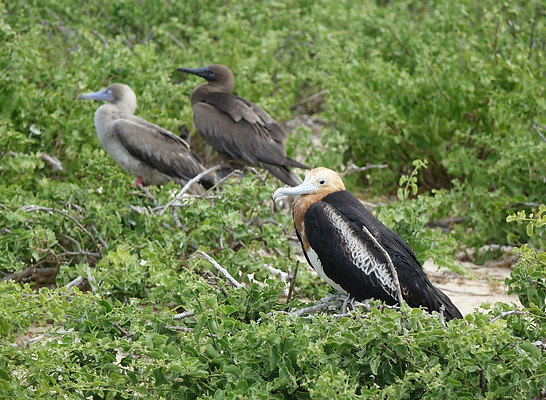
Bird Island -
Genovesa
Genovesa, also known as Tower Island, is the most northern in the Galapagos chain. Our last full day in the Galapagos began with a morning landing at a white sand beach in Darwin Bay, home to a colony of red-footed boobys plus a variety of seabirds. Birds everywhere!





A large colony of red-footed boobys make the island their home. The juveniles are all brown; as they mature, the facial area and beaks take on a bluish hue and the feet turn deep red.



Frigatebirds blending in with juvenile boobys.


Frigatebirds in various stages of maturity and mounting.



Yellow-crowned night heron hiding in the prickly-pear.

Nazca (masked) boobys
Lava gull
Swallow-tailed gull




Ever-present sea lions
"No-no-no, I'm a RED-footed booby - RED not blue!!

The Palo Santo tree (or bush) is also known as the incense tree and belongs to the same family as frankincense and myrrh. Several of our group took turns smelling a green tree on Punta Cormorant, the morning that we spent with the green sea turtles and attested that it did, in fact, smell like incense. The burning wood is used in purification rituals and has become so sought after, it has been declared "in critical danger" and cutting of live trees is now banned.

Our final expedition of the trip was an ascent up 90 feet, using a handrail. The question was "do I or don't I" - I decided it was a "do or die." The steep ascent up Prince Phillip's Steps led to a hike over an old lava trail through a Palo Santo forest.
As we circled the steps for a better approach, we had the chance to see yet another endemic species.


Endemic species:


Our trek around this part of the island was focussed on finding short-eared owls. Wow - so glad we had the great Nat Geo naturalists to help us. Even with their guidance, though, I had a tough time spotting these well-camoflauged birds.
Short-Eared owl
(Asio flammeus galapagoensis

Galapagos fur seal
(Arctocephalus galapagoensis)

Even on this last day, there are still new sights to see. A Nazca booby feeding its youngster (kid looks awfully big to be sticking its head down mom's or dad's gullet!).


Sleepy-eyed owl (Those eyes are their only camouflage give-away).

As we walked along, the guides kept pointing out the owls and directing us where to train our cameras or binoculars. I started nick-naming them. The guy above was "bush guy" - the guy below was "rock guy".




Seriously, I could not see the owl in here - so I just pointed my camera at the rock and hoped that I'd find it in post processing.

I was despairing of ever spotting one myself, when this guy showed up. He was a one-eyed old geezer that wasn't playing the hide-and-seek game!


Mr. Twisty-Head




Mr. Big

Endemic species:
Galapagos dove
(Zenaida galapagoensis
The final sighting of a species endemic to the Galapagos was this colorful Galapagos dove.